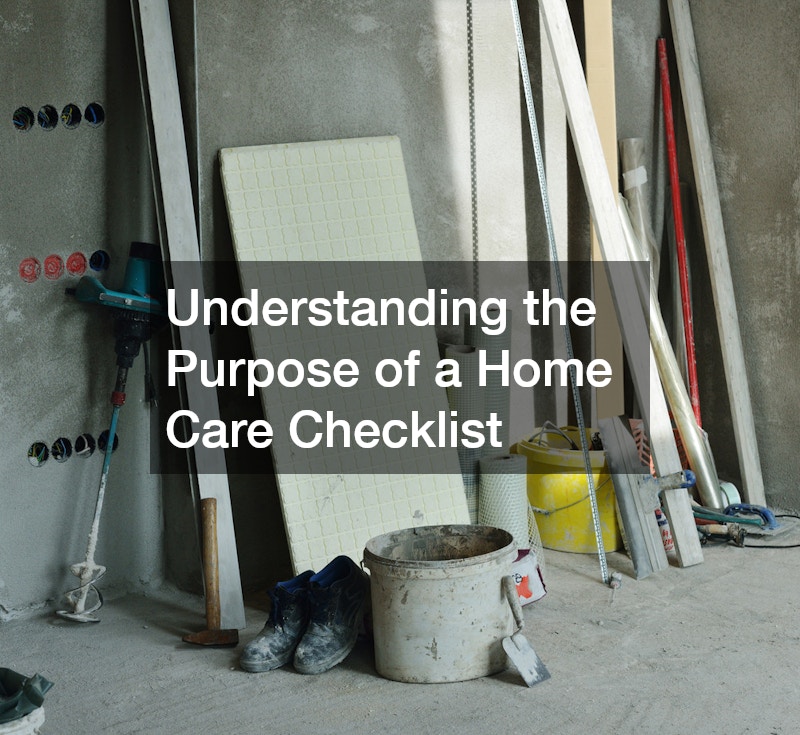Creating a Home Checklist
A home care checklist is an invaluable tool for families seeking to ensure that their home environment is safe, well-maintained, and supportive of their daily needs. This checklist serves as a guide to organize and monitor various tasks and responsibilities related to home upkeep, caregiving, and family well-being. Families today face numerous demands, from managing household maintenance to keeping track of health and safety requirements. With a well-structured home care checklist, these responsibilities become easier to manage, helping to reduce stress and improve organization. The checklist is especially useful for multi-generational households or families caring for older relatives, as it provides a framework for balancing routine maintenance and personal care needs. By establishing a clear list of tasks, families can ensure that essential needs are consistently met, creating a more secure and comfortable home.

Understanding the Purpose of a Home Care Checklist
The purpose of a home care checklist is to provide a clear, organized system for managing household responsibilities, ensuring no essential tasks are overlooked. By creating a comprehensive checklist, families can keep track of routine chores, necessary repairs, and health and safety precautions that contribute to a well-maintained living environment. This checklist serves as a roadmap, guiding families through a consistent and thoughtful approach to home care. It also allows multiple family members to contribute to household management, helping to distribute responsibilities and foster teamwork. With a home care checklist in place, families can avoid the stress of forgetting important tasks, creating a more organized and harmonious living space.
A home care checklist can also help families manage essential responsibilities associated with home insurance plans. For instance, certain home maintenance tasks, like checking smoke detectors or repairing leaks, may be necessary to meet insurance requirements and maintain coverage. By including these tasks on the checklist, families can ensure they meet the necessary criteria to protect their home investment.
Identifying Essential Components of a Home Care Checklist
A well-rounded home care checklist should cover a range of components that support the safety, functionality, and overall comfort of the home. Key categories often include regular cleaning, repair, and maintenance tasks, health and safety precautions, and any specific care needs for family members. By organizing the checklist into these essential areas, families can address both the physical upkeep of the property and the personal needs of household members. Routine tasks like inspecting appliances, replacing air filters, and scheduling seasonal maintenance can all be included. Additionally, a home care checklist can include reminders for health and safety measures, such as testing alarms and ensuring first-aid supplies are stocked. This level of organization promotes a comprehensive approach to home care, ensuring that nothing important is missed.
For families, incorporating specific services on the checklist, like a roofing company, helps ensure essential home maintenance tasks are regularly scheduled and attended to. For example, scheduling periodic roof inspections can prevent costly issues and protect the home from weather-related damage. Including a roofing company on the checklist serves as a reminder to stay proactive about roof maintenance, ultimately extending the life of the roof and supporting a safe, well-maintained home environment.

How a Home Care Checklist Enhances Family Organization
A home care checklist is a powerful tool for enhancing family organization. By consolidating tasks into a single, easy-to-reference list, families can better manage their time, resources, and responsibilities. When each family member knows what tasks need to be completed and when it reduces confusion and ensures that essential duties don’t fall through the cracks. A checklist fosters accountability, helping each family member understand their role in maintaining the household. This organized approach not only keeps the home running smoothly but also alleviates stress, as family members can anticipate tasks and plan around them. With a home care checklist, families can maintain a more structured routine, making it easier to balance home care with other daily commitments.
An organized home care checklist can also include coordination with essential home services, such as an alarm system company. Regular maintenance checks on home security systems can be scheduled into the checklist to ensure they remain in optimal working condition. By adding reminders for services like alarm system checks, families are better able to stay proactive about security, and protecting their household and belongings. Including these types of services within the checklist enhances organization by keeping all aspects of home care—from safety to maintenance—in one place, creating a reliable structure that families can depend on.
Improving Communication Through a Home Care Checklist
A home care checklist not only organizes tasks but also improves communication among family members. When tasks are clearly outlined, everyone in the household knows what is expected and can easily see where help may be needed. This shared understanding reduces the chance of miscommunication, which can sometimes lead to tasks being neglected or duplicated. By providing a clear and structured outline of household responsibilities, a checklist allows for better teamwork and support among family members. Improved communication through a home care checklist ensures that everyone is on the same page, making it easier to manage the household as a cohesive unit and minimizing the stress that can arise from unclear expectations.
Including specific maintenance tasks, such as coordinating with a drain cleaning company, can further enhance communication around home care. For example, a regular reminder for drain cleaning can prevent misunderstandings about when or how often such maintenance needs to be done. When these tasks are communicated through the checklist, families are less likely to overlook essential services, and everyone is informed of upcoming maintenance needs. The checklist acts as a communication tool, making it easy to coordinate efforts and ensure that each family member knows when to expect services and how to prepare, ultimately contributing to a more harmonious household.

Ensuring Comprehensive Care with a Home Care Checklist
A comprehensive home care checklist allows families to ensure that all aspects of home maintenance and care are covered. By structuring the checklist to include both routine and occasional tasks, families can achieve a balanced approach that addresses day-to-day needs as well as long-term upkeep. A thorough checklist includes everything from cleaning and safety inspections to larger maintenance projects and family-specific needs. This comprehensive approach ensures that the home remains safe, clean, and comfortable for all occupants, regardless of the season or changing circumstances.
For added security, including reminders to coordinate with specific service providers, such as a fence company, can help keep the home’s exterior safe and well-maintained. Scheduling periodic fence inspections or repairs, for example, helps to ensure that boundary security is in place and that the property remains in good condition.
Reducing Caregiving Stress Using a Home Care Checklist
A home care checklist is a valuable resource for reducing the stress that often accompanies caregiving and household management. When family members have a clear and organized list of tasks, it minimizes the feeling of being overwhelmed by responsibilities. Knowing exactly what needs to be done and when makes it easier to prioritize tasks and prevents the buildup of unaddressed issues. A home care checklist provides a sense of structure and control, which can be especially reassuring for caregivers managing multiple responsibilities.
For instance, including scheduled maintenance with air conditioning contractors on the checklist can help families avoid unexpected breakdowns or costly emergency repairs. A reminder to have the air conditioning system inspected and serviced regularly can prevent issues during peak seasons and keep the home comfortable year-round.

Maintaining Consistency in Care with a Checklist
Consistency is crucial for effective home care, and a checklist helps families achieve that consistency by providing a clear schedule and list of responsibilities. When home care tasks are completed regularly, it prevents the accumulation of issues and creates a stable, well-maintained environment. A consistent approach also means that family members know what to expect, fostering a greater sense of reliability and stability. A home care checklist ensures that nothing is overlooked, as each task can be marked as complete and revisited as needed. This consistency is particularly valuable for families with older adults or children, as it supports a routine that promotes well-being and comfort for everyone in the household.
Including tasks like coordinating with a stucco contractor in the checklist further enhances consistency in home maintenance. Stucco surfaces, for example, may need periodic inspection to prevent cracking or damage, which, if left unaddressed, can lead to more significant issues. By scheduling these tasks consistently, families can ensure that all aspects of home care—both interior and exterior—are addressed promptly, preserving the home’s appearance and structural integrity.
Adapting the Checklist to Meet Family Needs
A home care checklist is most effective when it is adaptable to meet the unique needs of each family. Different households have different priorities and schedules, and a one-size-fits-all checklist may not address these individual requirements. By customizing the checklist to include specific tasks or services, families can create a tool that aligns with their routines and addresses their unique challenges. This adaptability is especially useful when there are changes within the family, such as the arrival of a new family member, adjustments to a work schedule, or the addition of special care needs. A flexible home care checklist allows families to update their tasks as their circumstances evolve, ensuring that the checklist remains a relevant and helpful resource.
For example, incorporating tasks related to an electrical contractor may be essential for families in homes with older wiring or frequent electrical needs. Scheduling regular inspections or maintenance checks with an electrical contractor can help prevent potential hazards and ensure that the home’s electrical systems are functioning safely and efficiently.
Using a Home Care Checklist for Long-Term Planning
A home care checklist is not only useful for managing daily tasks but also for planning long-term care and maintenance needs. By including periodic and seasonal tasks, families can anticipate larger projects and budget accordingly. Long-term planning with a checklist allows families to prepare for home improvements, upgrades, or significant maintenance requirements well in advance, reducing the likelihood of unexpected expenses. This forward-thinking approach also helps prevent small issues from becoming costly problems, as families can address them on a routine schedule. With a home care checklist that includes long-term planning, families gain greater control over their home environment, making it easier to maintain both functionality and comfort over the years.
Incorporating tasks related to services from a dormer company, for example, can be part of long-term planning in homes that may need roof or dormer inspections. By scheduling these assessments every few years or as needed, families can ensure their dormers and roofing stay in good condition, preserving the integrity of the home and preventing costly repairs down the line.
Evaluating and Updating the Home Care Checklist
Regularly evaluating and updating a home care checklist ensures it remains relevant to the household’s evolving needs. Over time, family routines, maintenance requirements, and individual care needs can change, making it essential to adjust the checklist to reflect these updates. Regular evaluations help families identify tasks that may no longer be necessary or add new responsibilities that have become priorities. Updating the checklist promotes a proactive approach to home management, as families can adapt to seasonal demands, new technologies, and shifting household dynamics.
For example, families may need to add reminders for services like those provided by a heating contractor as colder seasons approach. Regular heating system maintenance, included in the checklist, ensures that the home remains comfortable and safe during winter. This ongoing process of evaluation and adjustment keeps the checklist relevant and practical, supporting families as they manage both immediate and future home care needs.
Implementing Your New Checklist
A home care checklist is an essential resource for families, supporting both day-to-day tasks and long-term home maintenance. With a well-organized checklist, families can manage household responsibilities more effectively, reducing stress and ensuring that nothing important is overlooked. From coordinating routine tasks to planning for future needs, a home care checklist provides the structure needed to maintain a safe, clean, and comfortable home. This tool also enhances communication and cooperation among family members, helping everyone understand their roles and work together to create a harmonious living environment.



